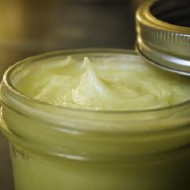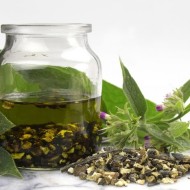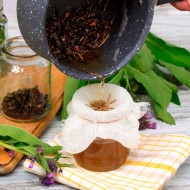What does comfrey grass look like and when is it used?
Content
- 1 Description and distribution
- 2 Chemical composition
- 3 Video "Useful properties of comfrey"
- 4 Medicinal and useful properties
- 5 How to plant and grow a larkspur in the country
- 6 Collection, procurement and storage of raw materials
- 7 The use of larkspur in folk medicine
- 8 Side effects and contraindications for use
Description and distribution
Larkspur is more often found in warm, humid climates, for example, in the Crimea or the Caucasus Mountains. It can be found in the Central regions of Russia and Siberia. There are about 25 species of comfrey in the world, 17 of which grow in Russia.
Since the plant needs a lot of moisture, it is located along river banks, in ditches and ravines, flood meadows. May appear at the forest edge. In order not to waste time looking, you can grow it in your own garden. A distinctive feature of the plant is the smell of cucumber, which is emitted by the leaves crushed in their hands.
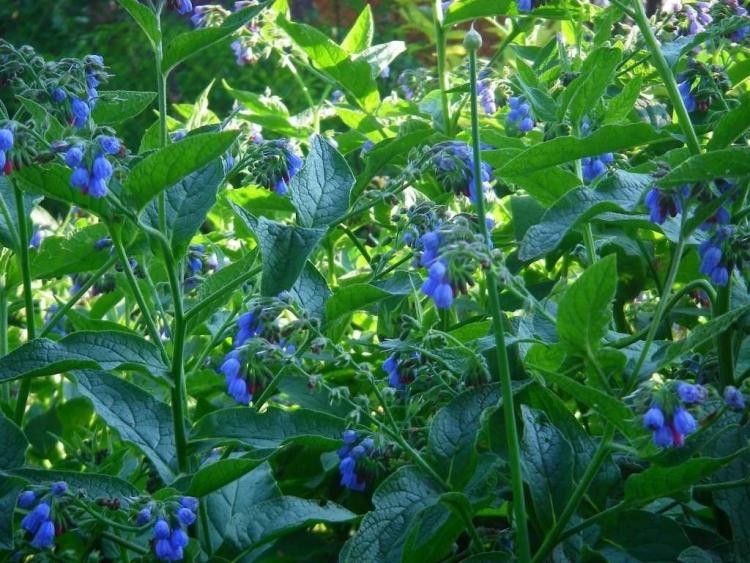
The plant has a branched stem up to 1 m in height, long, up to 15 cm, leaves of a dark green color. At the ends of the branches in May and June, small blue bells bloom, collected in bunches, which eventually turn purple. Seeds in the form of black nuts up to 5 mm in length ripen from July to September. The plant propagates by seed or by dividing the roots.
Chemical composition
The most valuable substances that make up the plant:
- vegetable mucus;
- organic acids;
- tannins;
- pyrrolizidine alkaloids;
- nitrogen compound allantoin (0.8% in roots).
Allantoin, which is part of comfrey, is an astringent and anesthetic for external use.
Video "Useful properties of comfrey"
This video describes the main useful and medicinal properties of the plant.
Medicinal and useful properties
Comfrey has been known to herbalists since ancient times. Especially valued is the root of the plant, which is harvested after flowering. Means made from larkspur are used to combat the following problems:
- wounds;
- fractures;
- kidney pathology;
- bronchitis, cough;
- pulmonary tuberculosis;
- inflammation of the gastrointestinal tract;
- diarrhea;
- metabolic disease.
As an external agent, it is used in the event of the following pathologies:
- stomatitis;
- purulent rash;
- cracks in the skin;
- trophic ulcer;
- dislocation;
- phlebitis;
- joint pain.
Infusions prepared from the aerial part of the plant help get rid of bleeding, hemoptysis, and chronic lung diseases. This is a unique remedy that allows you to quickly restore bones in fractures and heal wounds. Zhivokost helped people very much during the war.
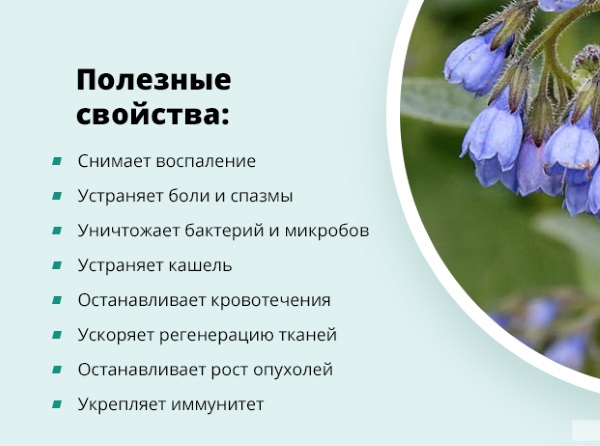
How to plant and grow a larkspur in the country
Zhivokost can grow on a personal plot or in a vegetable garden. When watering and feeding, this plant will begin to improve the condition of the soil, because it contains no less nitrogen than alfalfa. Comfrey grows on any soil, but does not like heavy and acidic soils. Watering should be moderate. At first, until the plant grows, it is important to weed the weeds. In general, no special care is needed.
The plant can be propagated by seeds by collecting them in the forest. However, this is difficult to do, since they do not ripen amicably and quickly crumble. It's easier to buy planting material or dig up a plant and transplant it into your garden.
When planting a live bone, you should adhere to the following recommendations:
- It is better to sow seeds before winter. Landing in the spring gives rare entries.
- Due to the large size of the plant, the row spacing should be at least 60 cm.
- Zhivokost does not need to be covered for the winter and protected from frost.
- The aboveground part must be mowed periodically, as the plant grows and can occupy a large area of land.
Collection, procurement and storage of raw materials
Most of the valuable allantoin accumulates in the comfrey root closer to cold weather. It is harvested in late autumn or early spring, as soon as the snow melts. The root is dug up, washed and allowed to wither a little. Then it is cut into pieces and dried at a temperature not exceeding 40 ° C. You can store the dried root in cloth bags, cardboard or wooden boxes for 3 years. Leaves are harvested only during flowering.

The use of larkspur in folk medicine
Due to its rich chemical composition, comfrey is widely used in folk medicine. Here are some recipes.
Infusion of leaves
Used for bruises to relieve pain. For cooking 2 tbsp. l. fresh leaves or 1 tbsp. l. dried pour 1 tbsp. boiling water and let it brew for 20 minutes. Filter the finished infusion, moisten it with a bandage or a napkin made of a simple cloth (preferably linen) and make compresses.
Comfrey is a low-poisonous plant, so you should strictly adhere to the dosage and be careful when working with raw materials.
Infusion from the roots
Comfrey root is called a catalyst for calcium metabolism for its ability to improve the absorption of calcium in the body. To prepare the infusion, 1 tbsp. l. insist crushed roots in 1 tbsp. boiling water 45 min. Strain the resulting product. Take the medicine 1/3 cup three times a day before meals. You can apply the prepared product externally.
Root tincture
Pour half a glass of finely chopped fresh roots with 0.5 liters of vodka. Insist in a dark place for 10 days, and then strain. Take 20-30 drops no more than 5 times a day, diluted in water.
Decoction of leaves and roots
For 0.5 liters of water, take 1 tbsp. l. dry raw materials. Boil for 5 minutes, and then insist for 1 hour. The broth is used both internally and for lotions, compresses and rinsing hair in case of loss.
Root ointment
Connect 1 part of roots and 4 parts of lard. Simmer on a steam bath for half an hour. Strain until the mixture is frozen. Keep refrigerated.
- Larkspur ointment
- Tincture for alcohol
- Comfrey broth
Side effects and contraindications for use
The plant should not be used for pregnant women, children and people with hypertension. Zhivokost can cause partial paralysis, so you need to work with it carefully, take it as prescribed by a doctor in the specified dose.
Comfrey treats many diseases of internal organs, but it is most valued for the fact that it promotes the rapid healing of fractures and wound healing. Pharmacies sell ready-made ointments for ligaments and joints with the extract of this medicinal plant.

